
All categories
Featured selections
Trade Assurance
Buyer Central
Help Center
Get the app
Become a supplier

(50 products available)













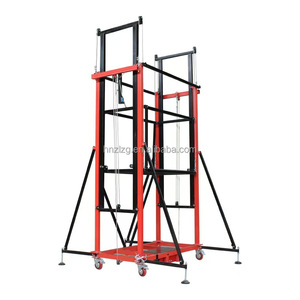
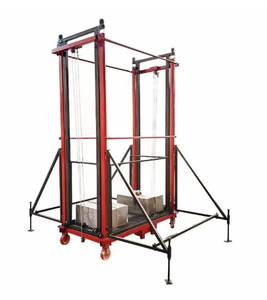

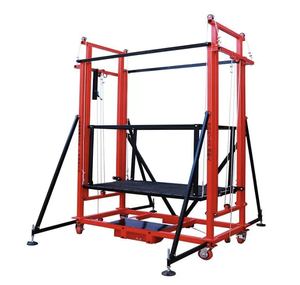
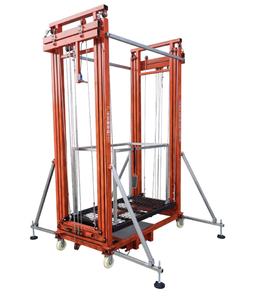
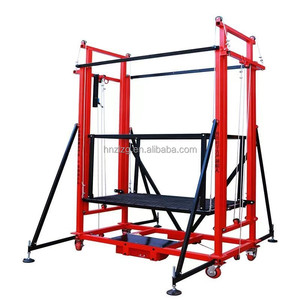



























There are different types of purchase scaffolding available. Below are the major ones;
System scaffolding
System scaffolds are prefabricated scaffolds that consist of standardized components that workers assemble according to predetermined configurations. This type of scaffolding is available in various systems, including the ring and pinion, modular, and Cuplock systems. The ring and pinion system consists of vertical tubes with rings and horizontal tubes with pins. The modular system has vertical standards, horizontal ledgers, and diagonal braces. The vertical standards, horizontal ledgers, and diagonal braces make the scaffolding stable. The cuplock system has vertical standards with cups and horizontal ledgers with pins. This system speeds up the construction process since the workers just connect the cups and pins to build the structure.
Frame scaffolding
This type of scaffolding consists of a lattice framework of standing and ledgers. The standing are the vertical posts, while the ledgers are the horizontal rails. The scaffolding is easy to erect and dismantle because of its frame structure. It is also stable and provides access to multiple levels. However, it is mainly suitable for low- and mid-rise construction projects. There are two main types of frame scaffolding: single and double scaffolding. The single scaffolding has vertical posts next to the wall. In contrast, the double scaffolding has vertical posts on both sides of the wall.
Rolling Scaffolding
Rolling scaffolding consists of a scaffold frame, platform, caster wheels, and outriggers. The caster wheels make the scaffolding support mobility. Workers can move the scaffolding from one point to another on the caster wheels. The wheels also have brakes to prevent movement when the scaffolding is in a specific position.
Suspended Scaffolding
These are temporary platforms that hang from the building's roof using ropes or cables. They are suitable for use in high-rise buildings. The platform is either manually or electrically adjustable. The suspended scaffolding consists of the hanging scaffolding, which workers build using standards, ledgers, and braces, and the single-tier scaffolding, where the platform is only one level.
Support:
Construction scaffolding beams provide a crucial platform for ongoing projects, enabling workers to safely and securely carry out their duties at all levels. Scaffolds are designed to hold their weight and additional materials, ensuring construction workers' safety.
Access:
Scaffolds are also important in providing easy access to high areas in a construction project. They are designed to be climbed easily, giving workers and construction personnel a safe way to reach hard-to-reach places.
Stability:
Scaffolding systems are crucial in ensuring stability in construction sites. They are built to be strong and stable, providing a steady platform for construction workers to work on. This reduces the risk of falls and injuries, making scaffolding an important part of any construction site.
Adjustability:
Scaffolds can be adjusted to different heights and angles, making them suitable for various construction projects. This feature makes scaffolds a preferred choice for construction project managers, as they can be used in multiple projects.
Material:
Scaffolds are made of durable materials such as aluminum or steel, which can withstand harsh weather conditions and the weight of workers and materials. This ensures scaffolds last for a long time and can be used in multiple construction projects.
Modular design:
Many scaffolding systems have a modular design, meaning they can be easily assembled and disassembled. This makes it easy to transport scaffolds to different construction sites and store them when not in use.
Versatility:
Scaffolding construction comes in different types, such as suspended and mobile scaffolds. This makes them suitable for different construction projects, and project managers can choose a type that fits their project needs.
Compliance:
Scaffolds usually comply with safety regulations and standards, ensuring they are safe for use in construction sites. This gives construction workers peace of mind, as they know these structures are safe and can be used on-site.
Construction Projects:
Scaffolds are widely used in construction projects to provide temporary platforms. This helps workers access different heights and complete tasks such as building, repairs, and maintenance. Scaffolds are essential in the construction industry as they ensure safety and efficiency when working on high-rise buildings or any construction project.
Historical Restorations:
Scaffolding is used in historical restorations to give support to workers and structures. It allows access to higher sections of the building. This makes it easy to restore and repair historical sites. Scaffolds are important in historical restorations since they ensure the process is done safely and efficiently without damaging the site further.
High-Rise Building Maintenance:
Scaffolds are used in maintaining high-rise buildings. They offer a safe platform that helps workers clean, repair, or replace windows, walls, and other structural components. Scaffolds are important for high-rise building maintenance since they ensure workers are safe while undertaking tasks in such heights.
Industrial Plants:
In industrial plants, scaffolds are used to support construction and maintenance operations. This enables workers to access machinery, pipes, and other components. Scaffolds are essential in industrial plants as they ensure workers can operate at heights safely, hence undertaking repair or maintenance of industrial components.
Shipbuilding and Repair:
Scaffolds are used in shipbuilding and repairing to help workers access different parts of the ship. This is especially in areas that are high or hard to reach. Scaffolds are important in shipbuilding since they ensure all parts of the ship are worked on effectively, hence building or repairing the ships safely.
Event Setup:
Scaffolds are used in event setups to create stages, lighting rigs, and other structures. This supports decorations and other items in elevated positions. Scaffolds are important in event setup since they ensure everything is set up safely and efficiently, allowing event organizers to complete tasks within a short time.
Exterior Painting and Inspections:
Scaffolds are used in exterior painting and inspections to allow workers access to high walls and surfaces. This enables them to carry out painting, inspection, and maintenance tasks efficiently. Scaffolds are important in these applications since they ensure workers are safe and tasks are undertaken at the right time.
When looking for a purchase scaffolding to meet specific needs, it is important to carefully consider a few factors. Here are some key elements to keep in mind:
Understanding the project requirements
Before anything else, it is important to clearly define the project requirements. This includes determining the height and scale of the project, the type of materials and equipment needed, and the duration of the project. For larger or longer-term projects, a more robust and reusable scaffolding solution may be required, such as a modular or rolling scaffold. On the other hand, for smaller, one-off tasks, a single-purchase scaffold may be sufficient.
Considering the type of scaffolding
There are different types of scaffolding systems in the market, including suspended, rolling, and frame scaffolding. Each type has unique features and advantages, so it's essential to choose the right one based on the project's specific needs. For instance, a hydraulic scaffolding would be a great choice for a project on a high-rise building, while a lightweight aluminum scaffold would be perfect for a project requiring portability and ease of setup.
Evaluating the quality and safety standards
The quality of the purchase scaffolding should never be compromised. Always look for scaffolds constructed with high-strength materials capable of withstanding the project's loads and stress. More importantly, ensure that the scaffolding meets local safety regulations and industry standards. This not only guarantees the safety of all personnel involved but also avoids any legal issues that may arise from non-compliance.
Assessing the supplier's reputation and support
Before settling on any supplier, it's good to do some research and read reviews from previous customers to get an insight into their experiences. This way, one can gauge the quality of the supplier's products and level of customer service. A reputable scaffolding supplier will provide excellent support before, during, and after the purchase.
Considering pricing and financing options
While price shouldn't be the sole deciding factor, it's still important to find a purchase scaffolding that fits within budgetary constraints. Take the time to compare prices and get quotes from different suppliers. Some may offer financing options or discounts for bulk purchases, which can be beneficial. Remember, the goal is to find a scaffold that provides the best value for the money, not just the lowest price.
Q1: What are the legal requirements for purchase scaffolding in my area?
A1: Legal requirements vary by location. Review local regulations to determine what is required for purchase scaffolding to be legally used at job sites in your area.
Q2: How can I prevent corrosion on my purchase scaffolding?
A2: Regularly inspect and clean the purchase scaffolding. Store it properly when not in use. Consider using galvanized or coated steel purchase scaffolding to prevent corrosion.
Q3: What is the maximum load capacity of purchase scaffolding?
A3: The maximum load capacity depends on the type of purchase scaffolding and materials used. For example, aluminum purchase scaffolding is lighter, while steel purchase scaffolding is stronger. Always refer to the manufacturer's specifications.
Q4: How should I store my purchase scaffolding?
A4: Store purchase scaffolding in a dry, cool place to prevent moisture buildup and corrosion. Keep it organized and ensure it's not stacked in a way that could cause damage.
Q5: How often should my purchase scaffolding be inspected?
A5: Inspect purchase scaffolding before each use and regularly to identify any signs of wear, damage, or corrosion. A thorough inspection by a qualified professional should be done at least once a year.